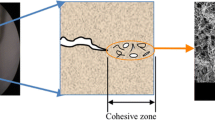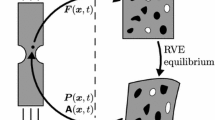Abstract
This paper presents a parallel generalized finite element method (GFEM) that uses customized enrichment functions for applications where limited a priori knowledge about the solution is available. The procedure involves the parallel solution of local boundary value problems using boundary conditions from a coarse global problem. The local solutions are in turn used to enrich the global solution space using the partition of unity methodology. The parallel computation of local solutions can be implemented using a single pair of scatter–gather communications. Several numerical experiments demonstrate the high parallel efficiency of these computations. For problems requiring non-uniform mesh refinement and enrichment, load unbalance is addressed by defining a larger number of small local problems than the number of parallel processors and by sorting and solving the local problems based on estimates of their workload. A simple and effective estimate of the largest number of processors where load balance among processors is maintained is also proposed. Several three-dimensional fracture mechanics problems aiming at investigating the accuracy and parallel performance of the proposed GFEM are analyzed.
Similar content being viewed by others
References
Babuška I, Caloz G, Osborn JE (1994) Special finite element methods for a class of second order elliptic problems with rough coefficients. SIAM J Numer Anal 31(4): 945–981
Babuška I, Melenk JM (1995) The partition of unity finite element method. Technical Report BN-1185, Inst. for Phys. Sc. and Tech., University of Maryland
Babuška I, Melenk JM (1997) The partition of unity finite element method. Int J Numer Methods Eng 40: 727–758
Belytschko T, Black T (1999) Elastic crack growth in finite elements with minimal remeshing. Int J Numer Methods Eng 45: 601–620
Belytschko T, Gracie R, Ventura G (2009) A review of extended/generalized finite element methods for material modeling. Model Simul Mater Sci Eng 17: 24. doi:10.1088/0965-0393/17/4/043001
Duarte CA (1996) The hp Cloud Method. PhD dissertation, The University of Texas at Austin, Austin, TX, USA
Duarte CA, Babuška I (2005) A global-local approach for the construction of enrichment functions for the generalized fem and its application to propagating three-dimensional cracks. In: Leitão VMA, Alves CJS, Duarte CA (eds) ECCOMAS Themat Conf Meshless Methods, Lisbon, Portugal, pp 11–14, July 2005 (8 pages)
Duarte CA, Babuška I, Oden JT (2000) Generalized finite element methods for three dimensional structural mechanics problems. Comput Struct 77: 215–232
Duarte CA, Kim D-J (2008) Analysis and applications of a generalized finite element method with global–local enrichment functions. Comput Methods Appl Mech Eng 197(6–8): 487–504. doi:10.1016/j.cma.2007.08.017
Duarte CA, Kim D-J, Babuška I (2007) Chapter: a global–local approach for the construction of enrichment functions for the generalized fem and its application to three-dimensional cracks. In: Leitão VMA, Alves CJS, Duarte CA (eds) Advances in meshfree techniques. Comput Methods Appl Sci, vol 5. Springer, The Netherlands ISBN: 978-1-4020-6094-6
Duarte CAM, Oden JT (1995) Hp clouds—a meshless method to solve boundary-value problems. Technical Report 95-05, TICAM, The University of Texas at Austin
Duarte CAM, Oden JT (1996) An hp adaptive method using clouds. Comput Methods Appl Mech Eng 139: 237–262
Duarte CAM, Oden JT (1996) Hp clouds – An hp meshless method. Numer Methods Partial Differ Equ 12: 673–705
Duflot M, Bordas S (2008) XFEM and mesh adaptation: a marriage of convenience. In: Eighth World Congr Comput Mech, Venice, Italy, July 2008
Farhat C (1988) A simple and efficient automatic fem domain decomposer. Comput Struct 28: 579–602
Farhat C, Roux FX (1991) A method of finite element tearing and interconnecting and its parallel solution algorithm. Int J Numer Methods Eng 32: 1205–1227
Hajjar JF, Abel JF (1989) On the accuracy of some domain-by-domain algorithms for parallel processing of transient structural dynamics. Int J Numer Methods Eng 28: 1855–1874
Hsieh S-H, Paulino GH, Abel JF (1995) Recursive spectral algorithms for automatic domain partitioning in parallel finite element analysis. Comput Methods Appl Mech Eng 121: 137–162
Hsieh S-H, Paulino GH, Abel JF (1997) Evaluation of automatic domain partitioning algorithms for parallel finite element analysis. Int J Numer Methods Eng 40: 1025–1051
Kim D-J, Duarte CA, Pereira JP (2008) Analysis of interacting cracks using the generalized finite element method with global-local enrichment functions. J Appl Mech 75(5): 051107
Kim D-J, Pereira JP, Duarte CA (2010) Analysis of three-dimensional fracture mechanics problems: a two-scale approach using coarse generalized FEM meshes. Int J Numer Methods Eng 81(3): 335–365. doi:10.1002/nme.2690
Kruis J, Matous K, Dostal Z (2002) Solving laminated plates by domain decomposition. Adv Eng Softw 33: 445–452
Li S, Mear ME, Xiao L (1998) Symmetric weak-form integral equation method for three-dimensional fracture analysis. Comput Methods Appl Mech Eng 151: 435–459
Melenk JM, Babuška I (1996) The partition of unity finite element method: Basic theory and applications. Comput Methods Appl Mech Eng 139: 289–314
Moës N, Dolbow J, Belytschko T (1999) A finite element method for crack growth without remeshing. Int J Numer Methods Eng 46: 131–150
Oden JT, Patra A, Feng YS (1992) An hp adaptive strategy. In: Noor AK (ed) Adapt Multilevel Hierarchical Comput Strateg. ASME, pp 23–46 (AMD-Vol. 157)
Oden JT, Duarte CA, Zienkiewicz OC (1998) A new cloud-based hp finite element method. Comput Methods Appl Mech Eng 153: 117–126
O’Hara P, Duarte CA, Eason T (2009) Generalized finite element analysis of three-dimensional heat transfer problems exhibiting sharp thermal gradients. Comput Methods Appl Mech Eng 198(21–26): 1857–1871. doi:10.1016/j.cma.2008.12.024
O’Hara P, Duarte CA, Eason T (2010) Transient analysis of sharp thermal gradients using coarse finite element meshes. Comput Methods Appl Mech Eng (submitted for publication)
OpenMP. Open multi-processing application programming interface. http://openmp.org/wp/
Pereira JP, Duarte CA, Guoy D, Jiao X (2009) Hp-Generalized FEM and crack surface representation for non-planar 3-D cracks. Int J Numer Methods Eng 77(5): 601–633. doi:10.1002/nme.2419
Pereira JP, Duarte CA, Jiao X, Guoy D (2009) Generalized finite element method enrichment functions for curved singularities in 3D fracture mechanics problems. Comput Mech 44(1): 73–92. doi:10.1007/s00466-008-0356-1
Quinn MJ (2004) Parallel programming in C with MPI and OpenMP. McGraw-Hill, New York
Raju JC, Newman IS Jr (1977) Three dimensional finite-element analysis of finite-thickness fracture specimens. Report TN D-8414, NASA-Langley Research Center, Hampton, VA, pp 1–40
Strouboulis T, Copps K, Babuška I (2001) The generalized finite element method. Comput Methods Appl Mech Eng 190: 4081–4193
Sukumar N, Moës N, Moran B, Belytschko T (2000) Extended finite element method for three-dimensional crack modelling. Int J Numer Methods Eng 48(11): 1549–1570
Top 500 supercomputer sites. November 2007 list. http://www.top500.org/list/2007/11/100
Ural A, Heber G, Wawrzynek P, Ingraffea A, Lewicki D, Neto J (2005) Three-dimensional, parallel, finite element simulation of fatigue crack growth in a spiral bevel pinion gear. Eng Fract Mech 72: 1148–1170
Author information
Authors and Affiliations
Corresponding author
Additional information
Submitted to Computational Mechanics.
Rights and permissions
About this article
Cite this article
Kim, DJ., Duarte, C.A. & Sobh, N.A. Parallel simulations of three-dimensional cracks using the generalized finite element method. Comput Mech 47, 265–282 (2011). https://doi.org/10.1007/s00466-010-0546-5
Received:
Accepted:
Published:
Issue Date:
DOI: https://doi.org/10.1007/s00466-010-0546-5




